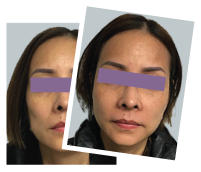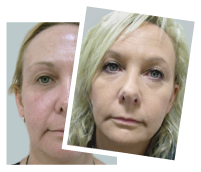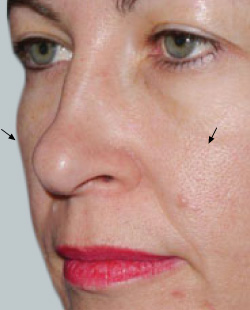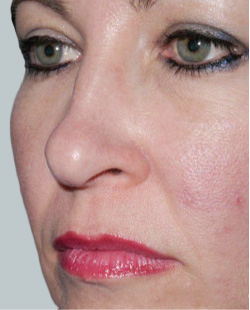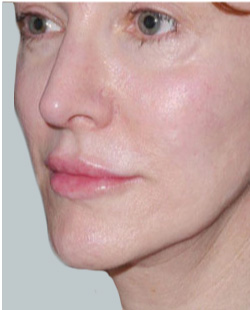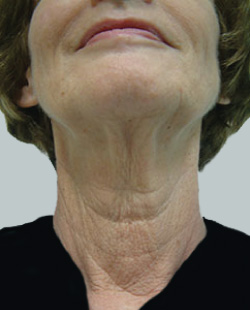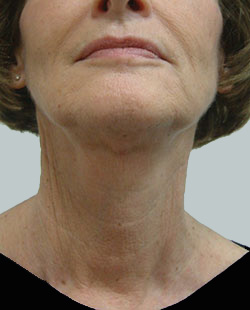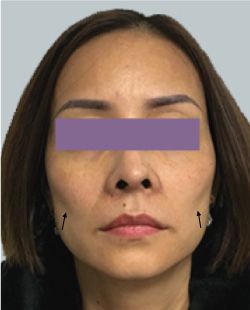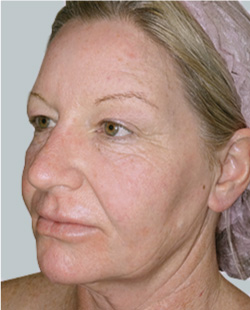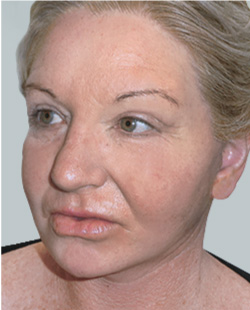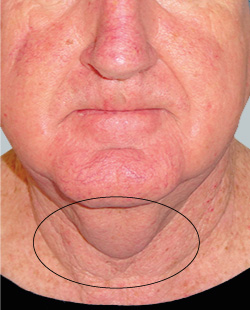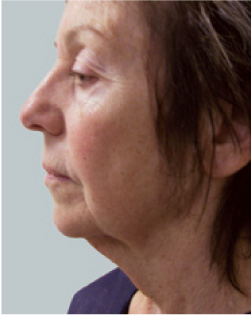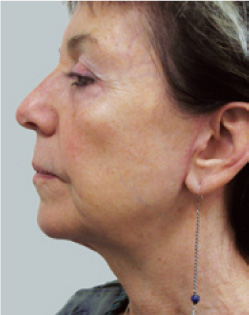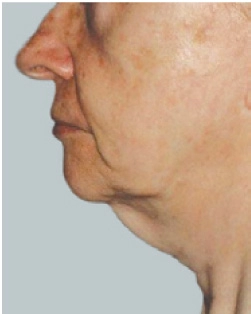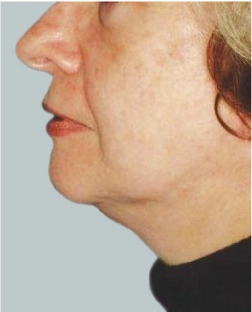Fat transfer to face procedure is a cosmetic procedure that restores lost facial volume using your own body fat. This procedure is also known as autologous fat transplantation, facial fat grafting or facial fat injections. This technique helps create a more youthful, natural look by filling in sunken areas, softening wrinkles, and enhancing facial contours.

The procedure involves two steps:
- Fat Harvesting — Fat is gently removed from areas like the abdomen or thighs using liposuction.
- Fat Injection — The purified fat is carefully injected into targeted areas of the face to add volume and smooth out wrinkles.
Unlike other volumising procedures, facial fat grafting is considered a long-lasting solution. While some fat may be reabsorbed by the body, a significant portion remains permanently. This makes it ideal for those looking for a natural alternative to other non-surgical volumising procedures.
If you’re looking for a long-term, natural solution to restore youthful facial volume, fat transfer to face may be the right option for you.
Before 
This 45-year-old patient sought facial treatment advice to restore volume lost from lower cheeks following molar tooth extractions.
After 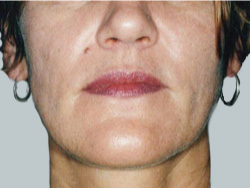
Facial volume was restored to the sunken areas using Fat transfer.
Performed By: Dr Ashley Granot (M0001026218) MBBS, FFMACCS (Med), FACP, FACNEM, ABBRM, MA5M Cosmetic Doctor, Melbourne
Benefits of Facial Fat Transfer
Autologous fat transfer restores volume and improves facial contours whilst using the patient’s own fat to rejuvenate the face. Fat transfer to face benefits include:
1) Natural-Looking, Long-Lasting Results
- Uses your own body fat, making the results more natural and seamless compared to synthetic non-surgical products. Facial fat injections are often preferred over nonsurgical volumising treatments due to their safety and reduced risks of side effects.
- No risk of allergic reactions since no foreign substances are introduced.
- Fat cells that successfully integrate into the face remain permanent, offering longer-lasting volume than fillers.
2) Minimally Invasive with a Short Recovery Time
- Less invasive than a facelift — no large incisions or extensive downtime.
- Fat is harvested using a gentle liposuction technique, reducing trauma to the body.
- Swelling and bruising typically resolve within a few weeks, with minimal discomfort.
3) Restores Volume and Improves Facial Contours
- Plumps sunken cheeks, hollows under the eyes, and temples for a refreshed, youthful look.
- Smooths deep wrinkles, fine lines, and folds, such as frown lines, marionette lines, and nasolabial folds.
- Fills tear troughs, reducing the appearance of dark circles and tired-looking eyes.
- Enhances jawline definition, helping to achieve a more balanced and sculpted face.
4) Improves Skin Quality Over Time
- Contains natural stem cells that can improve skin texture and elasticity.
- Helps rejuvenate dull, thinning skin by stimulating collagen production.
- Reduces acne scars, uneven texture, and fine lines, giving the skin a smoother appearance.
5) Dual Benefit: Facial Rejuvenation + Body Contouring
- Fat is harvested from areas like the abdomen, thighs, or flanks, helping to slim and contour those areas.
- Enhances both facial aesthetics and body shape in a single procedure.
6) Safer Alternative to Dermal Fillers
- Avoids risks associated with synthetic materials in non-surgical procedures, such as allergic reactions, migration, or lumpiness.
- Less chance of overfilling — fat is injected in precise amounts to maintain facial balance.
- No risk of foreign material rejection, making it biologically safe.
7) A More Affordable Long-Term Option
- Unlike other volumising procedures, which require regular maintenance treatments, fat transfer offers long-lasting results.
- Reduces the need for costly repeat injections every few months.
8) Customisable to Your Needs
Before 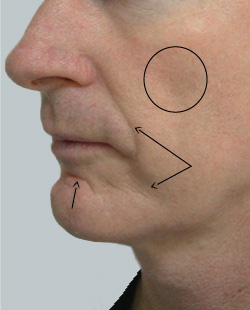
After 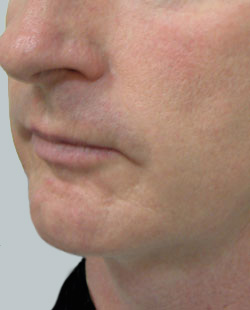
Performed By: Dr Ashley Granot (M0001026218) MBBS, FFMACCS (Med), FACP, FACNEM, ABBRM, MA5M Cosmetic Doctor, Melbourne
The Facial Fat Transfer Procedure
Facial fat transfer is a multi-step procedure designed to restore volume naturally while ensuring optimal fat survival and long-lasting results. The process involves harvesting fat, purifying it, and carefully injecting it into targeted facial areas. This surgery is done under local or general anesthesia.
1. Harvesting and Purification – Extracting and Preparing Fat for Injection
The first step of the procedure involves removing healthy fat cells from areas where you have excess fat, such as:
- Abdomen
- Thighs
- Hips or Flanks
- Lower Back
The Liposuction Process:
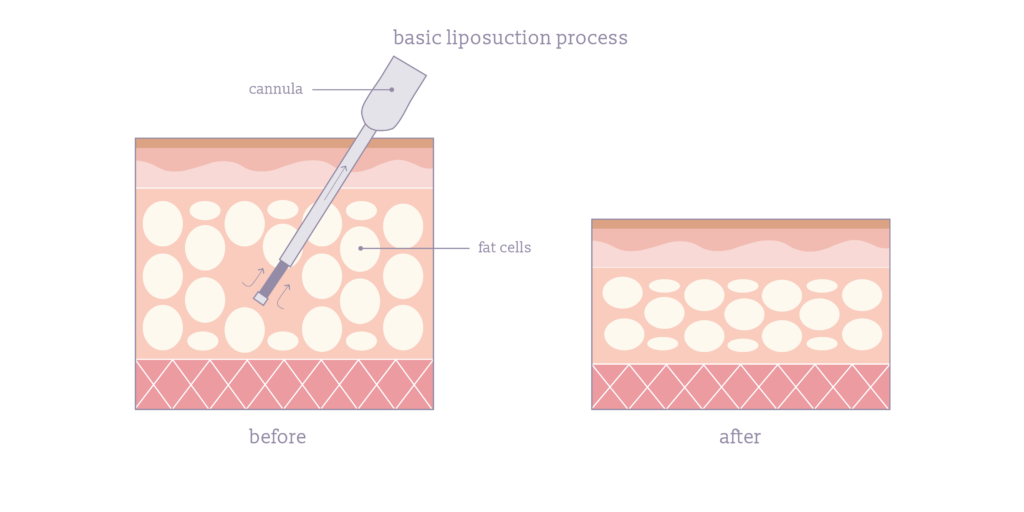
Fat is removed using gentle liposuction with a small, fine cannula to minimise damage to fat cells. A tumescent fluid (a mixture of saline, local anesthetic, and epinephrine) is injected into the area to reduce bruising and discomfort.
Only small amounts of fat are taken, ensuring the donor site remains smooth and contoured.
The Purification Process:
The extracted fat is placed into a centrifuge or a filtration system to separate pure fat cells from unwanted fluids, debris, and blood. This removes excess oil and non-viable fat, leaving behind only the highest-quality fat for injection.
The purified fat is then processed into tiny micro-fat or nano-fat particles, ensuring smooth integration into the facial tissue.
Purification is important as it:
- Removes unwanted substances that can affect fat survival.
- Ensures smoother results and prevents lumps or irregularities.
- Increases the longevity of the fat graft.
2. Injection and Placement – Sculpting the Face with Precision
Once purified, the fat is carefully injected into specific areas of the face to restore volume and enhance contours.
- The surgeon strategically injects tiny droplets of fat into different layers of the skin.
- The fat is placed gradually and evenly to mimic natural facial fat distribution.
- Multiple passes of injection enhance fat survival rates and create smoother, more natural results.
The injections are made in small droplets as:
- Ensures better integration with surrounding tissues.
- Improves fat survival by allowing blood supply to nourish the grafted fat.
- Creates a smoother, more natural-looking outcome without lumps.
The precision of fat injection is crucial — too much fat in one area can lead to poor fat survival or asymmetry, which is why experienced surgeons use a layered, gradual approach.
Common Areas Targeted for Fat Transfer to Face
- Cheeks – Restores plumpness and youthful contour.
- Under-Eyes (Tear Troughs) – Fills hollowing and reduces dark circles.
- Nasolabial Folds – Softens deep smile lines.
- Lips – Enhances volume naturally without synthetic fillers.
- Jawline & Chin – Defines and enhances facial proportions.
- Temples – Corrects hollowing and maintains facial balance.
- Forehead & Brows – Softens wrinkles and restores youthful volume.
- Scars & Depressions – Improves skin texture and evens out indentations.
Why Choose Facial Fat Transfer Over Other Volume Treatments?

- Fat transfer is a more natural and longer-lasting solution without the need for repeated injections that are required in other volumising procedures.
- It’s a less invasive option than facelifts with a shorter recovery period while still achieving a youthful, refreshed look.
Facial fat transfer is an excellent choice for those looking for a safe, natural, and long-term way to restore youthful volume without synthetic alternatives or major surgery.
| Feature | Facial Fat Transfer | Other Volume Treatments |
|---|
| Longevity | Permanent (some fat reabsorbed) | Temporary (6-18 months) |
| Material | Own body fat | Non-natural material |
| Natural Feel | Yes, integrates into facial tissues | Can feel slightly firmer |
| Allergic Reactions? | No (own fat) | Rare but possible |
| Downtime | 1-2 weeks | Minimal (1-3 days) |
| Cost | Higher upfront but long-term savings | Lower upfront but requires repeat treatments |
Am I a Good Candidate for Fat Transfer to Face?
Facial fat transfer is a natural way to restore lost volume, but it’s not for everyone. The best candidates for facial fat grafting are those who meet the following criteria:
- In Good Overall Health – No serious medical conditions that may interfere with healing.
- Non-Smokers or Willing to Quit – Smoking reduces fat survival and affects recovery.
- Have Lost Facial Volume – Due to aging, weight loss, genetics, trauma, or medical conditions.
- Have Sufficient Fat for Harvesting – Fat is taken from areas like the abdomen or thighs.
- Realistic Expectations – Understand that some fat may be absorbed and results take time to settle.
- Committed to a Healthy Lifestyle – A stable weight, good diet, and skincare routine help maintain results.

Fat transfer offers a permanent, natural solution to restore lost facial volume. With proper care, the results last for years, making it a cost-effective alternative to other volume treatments. If you’re looking for a long-lasting way to enhance your facial contours, fat transfer may be the perfect option for you.
Not sure if you’re a candidate? A consultation with a qualified surgeon can assess your suitability and provide personalised recommendations.
Fat Transfer to Face Recovery
Facial fat transfer has a moderate recovery period, with most swelling and bruising resolving within a few weeks. Following proper aftercare helps ensure smooth healing and long-lasting results.

What to Expect After Facial Fat Grafting Surgery
- Swelling and bruising peak in the first 3-4 days and gradually improve over 3-4 weeks.
- Mild discomfort is normal—pain can be managed with prescribed or over-the-counter pain relief.
- Some fat reabsorption occurs within the first few months before final results settle.
Aftercare Tips for Best Results
- Avoid touching, massaging, or applying pressure to the treated areas for at least 2 weeks.
- Sleep with your head elevated for the first week to reduce swelling.
- No intense exercise for 2-3 weeks — light activity can resume after a few days.
- Use cold compresses in the first 48 hours to minimise swelling.
- Stay hydrated and eat a balanced diet to support healing.
- Avoid smoking and alcohol — these can impair fat survival and prolong recovery.
- Maintain a healthy diet to support healing and sustain a natural glow in appearance.
When Will You Be Fully Recovered?
Most visible swelling subsides by 3-4 weeks, but subtle changes may continue for 3-6 months.
By 6 weeks, you should be fully recovered, with final results appearing after 3-6 months as the fat settles permanently.
Following post-op instructions carefully will help maximise fat survival and ensure the best possible results!
Fat Transfer to Face Results
Fat grafting to face offer permanent results once the fat settles, typically within 3-6 months. Whilst some fat is naturally reabsorbed, the surviving fat remains for years.
Fat behaves like natural facial fat where weight changes can affect results.

What Studies Suggest About Fat Survival
Some studies report that up to 30% or 40% of the graft volume is lost by the end of one year. The amount of transferred fat that survives depends on:
- Surgeon technique – Precise injection improves fat retention.
- Aftercare – Avoiding pressure on treated areas enhances survival.
- Lifestyle factors – Smoking, diet, and weight fluctuations impact long-term results.
Will I Need a Touch-Up?
- Some patients may need a second session if too much fat is absorbed.
- Follow-up treatments can be done after 6-12 months to enhance results.
- Touch-ups require less fat and downtime compared to the initial procedure.
How to Maintain the Best Results
- Keep a stable weight – Losing or gaining weight can alter results.
- Avoid smoking – It reduces blood supply and lowers fat survival rates.
- Follow proper aftercare – Swelling, bruising, and minor irregularities resolve over time.
Fat Transfer to Face Cost
The cost of facial fat transfer can vary depending on the location of the liposuction on the body, the amount of fat harvested from the area(s) and the surgeon’s experience. Me Clinic offers a starting price of $10,000 for fat transfer to face surgery.
During your consultation, our highly qualified plastic surgeon, will discuss the best options for you. You will then be provided with a quote to know exactly what is involved in your procedure and what it will cost.
Why Choose Me Clinic for Your Facial Fat Grafting?
At Me Clinic, we combine surgical expertise with a patient-first approach to deliver outstanding results for fat transfer to face surgery. Here’s why patients choose us:
- Our specialist plastic surgeons have extensive experience and training.
- We offer a customised treatment plan tailored to your specific facial anatomy and goals.
- Our clinic prioritises safety, comfort, and natural-looking results.
- We provide comprehensive post-surgery support to ensure a smooth recovery and long-lasting outcomes.
Book a Consultation with a Me Clinic Specialist Plastic Surgeon
Taking the first step towards your facial fat grafting procedure does not need to be hard. Booking a consultation at Me Clinic gives you access to experienced plastic surgeons who understand the importance of precision and patient care.
During your consultation, you can learn more about the procedure, talk about your specific concerns, and get a tailored approach that fits your needs and recovery timeline.
Get in contact with Me Clinic today to book a consultation and assessment via our contact form.
Or alternatively, you can contact Me Clinic in the following ways:
Dr Gary Kode
Specialist Plastic Surgeon (MED0001405964)
30+ years experience
25,000+ procedures
-Dr Gary Kode is a highly experienced Specialist Plastic Surgeon with over 33 years in Aesthetic and Reconstructive Surgery, having performed approximately 25,000 procedures. A Fellow of the Royal Australasian College of Surgeons (FRACS), he is renowned for his expertise in facelift surgery and breast augmentation, delivering natural and refined results.
Read moreDr Amir Tadros
Specialist Plastic Surgeon (MED0001375519)
18 years experience
10,000+ surgeries
+Mr. Amir Tadros is a triple board-certified Specialist Plastic Surgeon with over 25 years of experience, performing thousands of cosmetic and reconstructive surgeries in Australia, the UK, and internationally. His extensive training in world-renowned plastic surgery units and expertise in complex cases ensure patients receive the highest level of surgical precision and care.
Read moreDr David Ross
Specialist Plastic Surgeon (MED0001124797)
27 years experience
15,000+ surgeries
+Dr David Ross is a Specialist Plastic Surgeon with over 27 years of experience in plastic surgery and cosmetic procedures. Dr Ross also has public hospital appointments in supervisor roles, overseeing the training of 25 Specialist Plastic Surgeons during that time. Dr David Ross has published many articles on reconstructive and cosmetic plastic surgery while educating general practitioners.
Read more
Further reading related to fat grafting to face
Medical references for facial fat grafting
- Plastic and Reconstructive Surgery: Technical Precision with Autologous Fat Grafting for Facial Rejuvenation: A Review of the Evolving Science
{Visit} - Azoury, S. C., Shakir, S., Bucky, L. P., & Percec, I. (2021). Modern Fat Grafting Techniques to the Face and Neck. Plastic and reconstructive surgery, 148(4), 620e–633e. https://doi.org/10.1097/PRS.0000000000008405
Surgical Warning: Any surgical or invasive procedure carries risks. Before proceeding you should seek a second opinion from an appropriately qualified health practitioner.
Read more on the Risks of Surgery
How long does a facial fat transfer last?
Fat transfer results are permanent, but not all the fat survives. About 30-80% of the fat integrates, and the remaining is naturally absorbed within the first 3-6 months. The fat that remains will stay for years.
What are the fat transfer to face risks and complications?
As with any surgical or invasive procedure, facial fat transfer carries risks and complications. Any invasive procedure carries risks, so it is crucial for patients to understand the potential complications, which include infection, bleeding, scarring, and asymmetry.
Patients should discuss these risks with their plastic surgeon before undergoing the procedure.
How painful is facial fat transfer?
The procedure is done under local anaesthesia or general anaesthesia, so there is little to no pain during surgery. Afterward, patients may experience mild swelling, bruising, and soreness, which can be managed with pain relief medication.
How much fat is needed for facial fat transfer?
Around 30 to 50 mL are generally needed to contour the face using fat grafting, which is as little as two teaspoons. As a general rule, 100 ml is harvested to obtain 50 ml for injection.
How long does swelling last after fat grafting?
Swelling peaks within the first 3-4 days and gradually improves over 3-4 weeks. Subtle swelling may persist for 3-6 months as the fat settles permanently.
Is facial fat grafting worth it?
Yes, for those looking for a natural, long-lasting solution to facial volume loss. Unlike fillers, fat transfer offers permanent results, is biocompatible, and can also improve skin quality due to the presence of stem cells in fat.
Can fat grafting in the face be removed?
Unlike other volume treatments, fat transfer cannot be easily reversed. However, additional procedures, such as liposuction, may help reduce excess fat if needed.
How do you maintain fat after a transfer?
To maximise fat survival, maintaining a stable weight, avoid smoking and alcohol and following post-op care instructions is your best option.
How does fat transfer compare to non-surgical volume treatments?
- Fat transfer is permanent whilst alternatives usually last 6-18 months.
- Facial fat grafting is natural by harvesting the patients own fat compared to synthetic properties.
- Fat transfer costs more upfront but is more cost-effective long-term.













